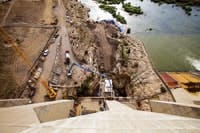John Fredell is Southern Delivery System program director for Colorado Springs Utilities. Fredell can be reached at [email protected].
As one of Colorado’s only major cities not located on a river, Colorado Springs has a long history of investing in complex systems to store, transport and treat water—from where it falls to where it is used. With its primary water infrastructure system approaching 50 years old and projections pointing to continued population increases, the city, like many others in the U.S., is determining how to meet future water needs and fund infrastructure. The county in which Colorado Springs is located is expected to grow from its 2010 population of 622,565 to 981,394 by 2040.
The U.S. Environmental Protection Agency (EPA) projects that the nation’s water systems need to invest some $335 billion between 2007 and 2027 to continue delivering safe drinking water and protect public health. Pipes, treatment facilities and reservoirs must be maintained and upgraded to meet changing regulations and increasing demand.
The SDS Story
After two decades of planning, permitting and approvals, major construction began in 2011 on the nearly $1-billion Southern Delivery System (SDS) project, a regional delivery system that will transport Arkansas River water stored in Pueblo Reservoir to the southern Colorado communities of Colorado Springs, Fountain, Security and Pueblo West. The project will supply these communities with water through 2050.
Starting in 2016, SDS will transport water from Pueblo Reservoir through approximately 60 miles of underground pipeline and three pump stations to a new water treatment plant. Work on the SDS connection to Pueblo Dam and raw water pipeline construction began in 2011. Future phases will include constructing a terminal storage reservoir and exchange reservoir, as well as expanding pumping and treatment capacity. Construction of Phase I of SDS will take five years, generate hundreds of jobs and pump millions of dollars into local economies.
SDS is one of the largest water projects to be built in Colorado in decades. In many ways, current economic conditions have made this an opportune time to build SDS. The project has benefitted from historically low interests rates, and materials and services are competitively priced. Bids on initial construction work have been about 20% below budget.
Jobs & Money
There is a strong pool of highly qualified contractors eager to work on the project. For Phase I construction alone, SDS is estimated to generate an average of 700 jobs annually. SDS will infuse cash into the economy in the short term and enable Colorado Springs to retain and attract businesses for the long term.
According to a recently published independent economic study commissioned by the Colorado Springs Chamber of Commerce Center for Regional Advancement, as many as 13,175 jobs could be generated by a region certain of its water supply. Further, without SDS, employment growth in Colorado Springs is expected to be 36% lower than it would be with SDS by 2050.
While the city welcomes economic benefits to its region, Colorado Springs Utilities (CSU) is doing all it can to design and build the project affordably. To date, CSU has identified engineering changes that will result in more than $50 million in savings. It also has phased project construction, allowing Colorado Springs to phase in and level out rate increases to minimize impacts to customers.
Environmental Responsibility
In addition to closely watching how ratepayers’ dollars are being spent, CSU is working diligently to build an environmentally responsible project. Environmental impacts of SDS have been studied extensively. Because the project required a major federal action by the U.S. Bureau of Reclamation to issue contracts for using Pueblo Reservoir, an environmental impact statement was required under the National Environmental Policy Act.
In March 2009, after nearly six years of analysis and public process, the Bureau of Reclamation issued its record of decision for the SDS project, identifying the pipeline from Pueblo Reservoir as the preferred alternative. The U.S. Army Corps of Engineers and the EPA were cooperating agencies in the comprehensive environmental review.
For unavoidable project impacts, SDS will implement responsible mitigation measures. A Fish and Wildlife Mitigation Plan, developed with the Colorado Division of Wildlife, outlines a blueprint for mitigation that includes improving fish habitat and maintaining flows on regional waterways. Additionally, as part of a land-use permit with Colorado Springs’ downstream neighbor Pueblo County, SDS will contribute $50 million for improvements to Fountain Creek, the stream Colorado Springs uses to discharge treated effluent.
The long-term benefits of SDS transcend water delivery by benefiting fish and wildlife habitat and offering recreational opportunities for the entire region.
Reliable Water
CSU is continuing its community’s legacy of visionary water planning with construction of the SDS project by providing reliable water for generations to come.
Download: Here


